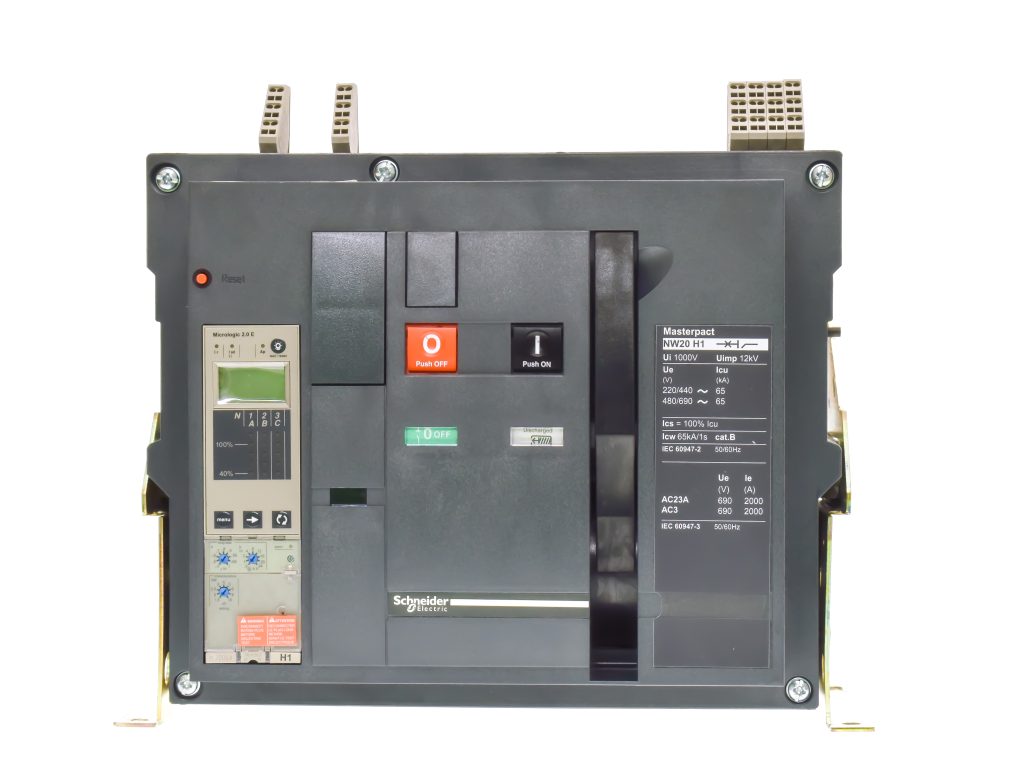In this article, we intend to analyze the concept of an air circuit breaker and understand its various types in the Iranian market. Initially, it is essential to obtain an accurate definition of an air circuit breaker and delve into its applications.
What is an Air Circuit Breaker?
An air circuit breaker is defined as one type of automatic switch with low pressure, used for high currents. This type of breaker is designed and manufactured to handle currents ranging from 630 to 6300 amperes and possesses the capability to protect circuits against overload, instant and delayed short circuits, and grounding. Air circuit breakers are divided into two types: NT and NW, and are employed for panel inputs. These breakers typically carry high currents and facilitate the establishment of selective modes between inputs and outputs.
Why are these types of breakers called “air” circuit breakers?
The reason for naming these types of breakers “air” is that the arc extinction process occurs when pressing the switch in a chamber filled with compressed air. Therefore, the contacts of the breaker must travel a long distance to extinguish the arc. This action leads to the generation of additional gases that need to be expelled from inside the breaker. Dimensionally, air circuit breakers are larger than vacuum and SF6 circuit breakers. In these types of breakers, accessing the main contacts by removing the arc chutes is easily feasible, while in other breakers, this possibility does not exist.
The Role of Air Circuit Breakers
Air circuit breakers have two main functions. Their first function is switching or connecting the network, and their second function is to protect the network under conditions such as short circuits, voltage fluctuations, frequency increases, equipment overheating due to excessive current flow and overload, and desynchronization of generators from the network.
Structure of Air Circuit Breakers
The design of air circuit breakers is such that they can automatically disconnect the circuit via a relay or manually from the control room, under voltage and load conditions, and during short circuits where the current passing through the circuit may be up to 10 times the rated current in the circuit breaker. Air circuit breakers are designed to protect electrical circuits against hazards such as overload, short circuits, and grounding, and are also used to protect motors and generators. Unlike fuses, which operate once and then need to be replaced, these breakers have the capability to re-enter the circuit automatically or manually.
Components of Air Circuit Breakers
– Connect button
– Counter or operation counter of the breaker
– Disconnect button
– Main contacts
– Power input and output terminals
– Control terminals including auxiliary contacts, shunt relay, under-voltage relay, motor, etc.

Disadvantages of Air Circuit Breakers
One of the disadvantages of air circuit breakers is that their contacts must travel a long distance to extinguish the arc. They have larger dimensions compared to vacuum and SF6 circuit breakers. Additionally, extinguishing the arc generates additional gases that must be expelled in a controlled manner.
Installation of Automatic Air Circuit Breakers
When installing automatic air circuit breakers, the following points must be observed:
– Ensure minimum required safety by using appropriate interlocks between the breakers to protect operators and facilities.
– Medium voltage power switches must be selected based on standards such as IEC 56 or other reputable standards.
– Pressing or inserting the breaker into the enclosure in drawer panels or removing it should not pose a hazard to the operator.
– Access to medium voltage circuit breakers in panels during operation, servicing, and repairs should be easy.
– The enclosure of the medium voltage circuit breaker must be designed to withstand the effects of ambient temperature, operating temperature, and short circuits without affecting the durability of the panel.
– The protection level of the panels must be compatible with the protection level of the breakers.